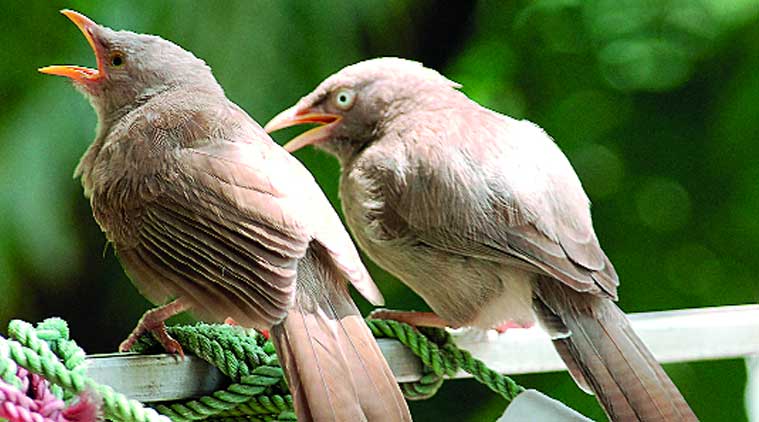Watch the grumpy jungle babblers canoodle, and you’ll melt into mush
Like most citizens of the capital, they glower and scowl and frown most of the time, to say nothing of the incessant grating racket they make — “kay-kay-kay” as they go about their daily business.
 They might not be very friendly, but they do have a knack for TLC (Source: Ranjit Lal)
They might not be very friendly, but they do have a knack for TLC (Source: Ranjit Lal)
Out in the wild, I confess I wouldn’t look at them twice (being too distracted by other things), but here in the urban jungleland of Delhi, they are top favourites. Like most citizens of the capital, they glower and scowl and frown most of the time, to say nothing of the incessant grating racket they make — “kay-kay-kay” as they go about their daily business. They’re dressed in untidy khaki-brown uniforms and remind me of cops in more ways than one.
Take their daily business, for example. They’ll enter your garden before daybreak, glowering and muttering and commence searching and probing under stones, twigs and leaves, tossing them asunder with no respect for your property or privacy, or the fact that you’re still in your pajamas. Like they’ve been tipped off that you’ve buried a hoard of gold ingots there or stashed away a ton of cocaine. Any spiders, cockroaches, beetles, grubs, butterflies, etc they find they confiscate at once — by swallowing. Laugh at them, and they’ll bunch together, feathers mussed up, hunchbacked and bounce towards you ferociously, their tails swinging loosely behind them as threateningly as lathis. If they discover that you’ve hired a flint-eyed tomcat as muscle, all hell will break loose as they heckle and jeer the feline incessantly, till it slinks away, lashing its tail in impotent disgust.
Sometimes, preferably in the middle of the afternoon, they’ll line up outside your window and bang on it with their beaks, demanding entry. They are, of course, incensed that you’ve let another posse of keystone cops inside who are pecking and jeering at them sweltering there in the blistering sun.
Watch them fly and it’s guaranteed you’ll get the giggles. Lined up on a branch, the leader will glare at his cowardly lieutenants and take off, fluttering his wings madly, then gliding, then fluttering, losing height all the while and with very little control over where he is heading. He lands, bumping and bouncing, and right behind him his loyal followers will have already launched off and the whole flock will have to take care that they don’t land in a higgledy-piggledy heap one on top of another. For them, hopping seems a better way of getting around.
Jungle babblers are like that only.
But why, you might ask, should a bird that reminds you of the capital’s good citizens, loaded to the eyeballs with road-rage as they are, be such a favourite? Well my eyes were opened when I looked at the bottlebrush tree outside my bedroom one morning. There, on a branch, all in a row, six or seven tucked tightly abreast, were these angry looking birds, preening each other with such TLC that they would have given the moral police instant multiple aneurysms. Each bird was riffling its beak through the plumage of its neighbour, with fierce gentleness, while the recipient of this disgraceful PDA and tenderness rolled its eyes in sheer, nirvana bliss — needless to add, frowning away to glory all the while. “Ah that spot…yes, yes, yesss, oh baby!” Technically it’s called “allpreening”; I prefer to call it allcanoodling. Make no mistake, these guys are the biggest softies around! Now that their secret was out I found out more about them.
They belong to a huge clan, with perhaps more species than any other amongst the perching birds, and they’re Old World residents. They live in territorial groups of up to a dozen members, but often numbering six or seven. From this, they get their sobriquet saat bhai (seven brothers) in Hindi and “seven sisters” in English (No research has been done regarding the reasons behind the transmutation as far as I know). They nest in summer and the monsoon, and each group usually has one breeding pair comprising the top ranking gentleman and lady. Nests are built in thickets, bushes and trees, usually placed two to maybe 10 metres up. Non-breeding members of the “sisterhood” help feeding the fledglings (usually three or four) and encourage them to fly when the time comes.
They often tolerate incursions by other groups into their territories, and bunch together making a ferocious racket when a predator (cat, mongoose, snake etc) appears on the scene, mobbing it till it slinks off. Conbirds like pied cuckoos and common hawk-cuckoos often lay their eggs in their nests and the babblers continue to feed their giant imposter offspring till it gets out of the nest and gives them the willies because even hawk cuckoo babies do look like hawks… But once the baby settles down, and opens its beak and wheezes, it has its face stuffed with goodies again by doting parents who desperately need counselling! Little boy babblers apparently stay on with the family, while girl babblers fly off into the big bad world to seek fame and fortune (and prevent inbreeding). I suppose it could work the other way too, but there you have it, and good for them. You can laugh at these glowering humbugs in parks, gardens, forested areas, both in the city and in the wild nearly all over India — and they will never fail to entertain you. And this despite the fact that they — and their larger cousins — large grey babblers, have never been known to smile.
Still, it would be nice if people — and especially the police — began each day in the manner of those babblers on the bottlebrush tree that morning.
Ranjit Lal is an author, environmentalist and bird-watcher





- 01
- 02
- 03
- 04
- 05






















